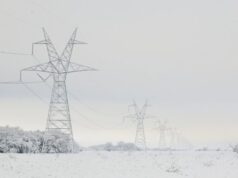A team of scientists has successfully teased out the influence of human-caused climate change on wintertime precipitation over much of the last century, showing that the warming climate is significantly altering wintertime rainfall and snowfall across the Northern Hemisphere.
The study, led by scientists at the National Center for Atmospheric Research (NCAR), used an innovative approach that relied on observations of precipitation and large-scale atmospheric circulation patterns, along with statistical techniques and computer climate simulations. This enabled the research team to identify the amount of average monthly precipitation in specific regions of North American and Eurasia that fell as a result of human impacts on the climate, rather than natural variability.
“I thought this was quite revealing,” said NCAR senior scientist Clara Deser, a co-author of the study. “Our research demonstrates that human-caused climate change has clearly affected precipitation over the past 100 years.”
The results show that warming temperatures associated with human emissions of greenhouse gases spurred a noticeable increase in wintertime precipitation across widespread regions of northern Eurasia and eastern North America since 1920.
The work may point the way to more detailed studies into the influence of climate change on precipitation changes year-round. Precipitation globally is projected to increase by an average of 1-2% per additional degree Celsius because a warmer atmosphere holds more water vapor. But local changes may be highly variable, with some regions becoming dryer and others far wetter.
Find your dream job in the space industry. Check our Space Job Board »
The study, by scientists at NCAR, Lanzhou University in China, and the University of Toulouse in France, was published in the AGU journal Geophysical Research Letters. It was funded in part by the National Science Foundation, which is NCAR’s sponsor.
Subtracting the influence of natural variability
Scientists for years have conducted attribution studies to determine the extent to which changes in weather patterns can be attributed to human influence on climate. Using computer models and observations, national and international teams of researchers have repeatedly demonstrated that globally warming temperatures since the 1950s are largely due to societal emissions of carbon dioxide and other heat-trapping greenhouse gases.
But determining the role of greenhouse gases in century-long precipitation trends across continents is highly challenging, because precipitation is affected by localized and variable weather conditions, making it difficult to discern the long-term changes amid the noise of day-to-day and year-to-year changes in weather. Scientists have previously relied on large numbers of climate model simulations to try to detect the signal of long-term precipitation trends.
In the new study, the researchers used observations, rather than climate models, to determine the influence of a changing climate on precipitation. They essentially reduced the question to a subtraction problem: if you take away the amount of precipitation that’s caused by natural variability, then the difference between that and what actually fell can likely be attributed to society’s impact on climate.
The scientists turned to an innovative approach known as dynamical adjustment. This consisted of applying statistical techniques to observations of large-scale circulation patterns in the atmosphere for every winter month from 1920 to 2015. These circulation patterns, such as the location of high- and low-pressure systems over North America and Eurasia, occur independently of the build-up of heat-trapping greenhouse gases.
By aggregating all the circulation patterns, the researchers could estimate the typical amount of precipitation that would fall when a particular circulation pattern occurs. The team then compared the results to measurements of the precipitation that actually fell. The difference between the two—the amount of precipitation that would be associated with the large-scale circulation patterns under natural conditions and the actual precipitation trends—revealed the influence of climate change.
The results showed that the warming climate has led to increased wintertime precipitation across northeastern North America, as well as a small region of northwestern North America. Climate change also has contributed to an increase in precipitation across much of northwestern and north central Eurasia.
In contrast, the study indicated that climate change may have had had a drying influence on parts of central and southwestern North America—although not enough to offset natural variability—and on much of southern Eurasia. However, the authors cautioned that the results for those regions were less pronounced and not statistically significant.
Deser and her colleagues focused on winter because precipitation during that time of year is driven by broad atmospheric patterns that are easier to see in the data than localized conditions that affect summer precipitation, such as soil moisture and individual thunderstorms. They concentrated on the Northern Hemisphere because it contains far more measurements of precipitation than the Southern Hemisphere.
The results were in good agreement with climate model simulations of human-induced changes in precipitation, providing an independent verification of the models.
“Scientists previously turned to climate models for answers. Here, the climate models come in only at the end to confirm what we teased out of observations independently,” said NCAR scientist Flavio Lehner, a co-author of the study. “I think this is the major scientific breakthrough of this work.”
Lehner and Deser used the same technique in a separate study, published in Geophysical Research Letters last year, to show that recent drying in the U.S. Southwest is largely attributable to natural variability.
Supporting evidence from international studies
The new study relied on detailed, international datasets of historic precipitation measurements and atmospheric circulation patterns. It also drew on two datasets of global climate simulations. One, known as the Large Ensemble, used the NCAR-based Community Earth System Model (CESM) to create 40 simulations of global climate beginning in 1920—each one with slightly different starting conditions. The other consisted of simulations from 37 world-leading climate models, including the CESM, that were used for an international climate research project known as the Coupled Model Intercomparison Project 5 (CMIP5).
The findings lend support to international studies that have used powerful climate models to try to discern the influence of greenhouse gases. For example, the CMIP5 project showed a similar pattern of precipitation trends due to climate change. That research relied entirely on computer simulations, and its results were less detailed than the new study.
“When we saw how well our approach, which is based entirely on observational data, agreed with the climate models, we were surprised because these are two independent ways of looking at climate change,” Deser said. “The degree of agreement with both the amplitude and the spatial patterns of precipitation change was really impressive.”
Provided by: American Geophysical Union
More information: Ruixia Guo et al. Human Influence on Winter Precipitation Trends (1921–2015) over North America and Eurasia Revealed by Dynamical Adjustment. Geophysical Research Letters (2019). DOI: 10.1029/2018GL081316
Image: This map shows the influence of human-caused climate change on wintertime precipitation in the Northern Hemisphere from 1921 to 2015. The warming climate has spurred significant increases in precipitation across much of northeastern North America and northern Eurasia. The stippled regions show precipitation trends that are statistically insignificant.
Credit: Simmi Sinha, UCAR, redrawn from map by Ruixia Guo of Lanzhou University and NCAR











